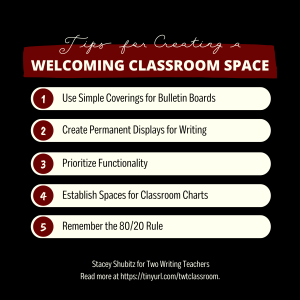Estimated reading time: 3 minutes. (Contains 606 words.)
Primary Audience: Classroom Teachers
Catch Up Quick: Several years ago, I wrote about the “Pinterest-ization of Education,” which has led to an overwhelming emphasis on elaborate classroom decorations. However, creating a welcoming and engaging classroom can be done without hours of decorating. Teachers can foster a student-centered environment that celebrates individuality and promotes engagement by dedicating substantial wall space for students’ use.
Why It Matters: Prioritizing ample wall space for student work fosters a student-centered classroom environment. It promotes student ownership and engagement and celebrates their unique contributions, ultimately enhancing their learning experience.
What’s Happening: As the school year winds down, you’re thinking about what to toss and keep from this school year. Perhaps you’re packing everything up so the floors can be waxed or walls can be painted during the summer. You might be trying to make it through days of trips, field days, and parties. Or maybe you’re just counting backward to the final days of the school year because it has been a year. I see all of you out there!
If you’re thinking about what your 2024-25 classroom will look like as you march toward summer break, I want to share some practical tips for creating a welcoming space for students that doesn’t require hours of labor when you return after the summer break.
- Use Simple Coverings for Bulletin Boards: Opt for plain fadeless paper and simple borders to cover bulletin boards, leaving room for student work. Label them with signs indicating they are “coming soon” or will feature “work in progress.” Alternatively, consider more durable coverings such as wallpaper or fabric.
- Create Permanent Displays: Devote time to creating permanent displays featuring students’ work throughout the year. For example, a bulletin board showcasing published writing at the end of each unit of study can be a source of pride and inspiration for students.
- Prioritize Functionality: While some may feel pressure to create a picture-perfect classroom, prioritize a simple and functional aesthetic instead. For instance, empty bulletin boards are opportunities for student work rather than decorating shortcomings. Adopt a “less is more” mentality, minimizing distractions by hanging only learning-focused items like word walls and anchor charts. This mentality ensures your classroom fosters student engagement and focused attention.
- Establish Spaces for Classroom Charts: Designate specific areas for classroom charts related to writing workshops, reading workshops, math strategies, and more. Color-coding or categorizing charts helps students quickly locate and utilize the resources for various subjects.
- Remember the 80/20 Rule: Beth Moore taught me about this rule. 80% of the classroom displays are student-created, ensuring that at most 20% of the walls are covered on the first day of school or at any point of the school year.
The Bottom Line: Creating a student-centered classroom prioritizes student work, individuality, and engagement over elaborate decorations. By embracing ample wall space for student creations, teachers can foster a sense of ownership, promote collaboration, and celebrate student achievements. Let us shift our focus from picture-perfect classrooms to classrooms that empower and inspire our students throughout their educational journey.
Go Deeper:
- A holistic, multi-level analysis identifying the impact of classroom design on pupils’ learning by Peter Barrett, Yufan Zhang, Joanne Moffat, Khairy Kobbacy
- Bulletin Board Solutions by Angela Watson
- Rethinking the Colorful Kindergarten Classroom by Jan Hoffman
- The Culture of Cute in the Classroom by Angela Watson
- The Aesthetics of Joy from Ingrid Fetell Lee
- Welcome to Writing Workshop: Engaging Today’s Students with a Model That Works (Chapter Two: The ‘Write’ Environment) by Stacey Shubitz and Lynne R. Dorfman
Discover more from TWO WRITING TEACHERS
Subscribe to get the latest posts sent to your email.


